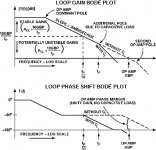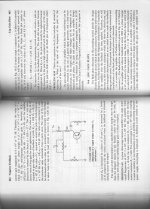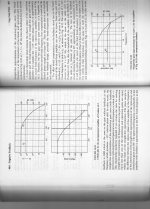He detected them immediately, despite wanting not to.
Exactly. I wish that "all amplifiers sound alike if they measure well enough." But they don't. When I sold Audio Research back in college,
I listened to each amp, after burning them in and biasing to the line voltage. Not only did the D51, D76A, and D150 amps all sound
very different from one another, but there were substantial differences in sound from unit to unit of the same model. The first D150 I got
was so bad that I had to remove the input high and low filtering to get it to sound passable.
I won't even get into the solid state D100 and SP4, which of course measured far better than the tube stuff, but sounded much worse.
Why would a rational person want audio equipment to sound less than perfect? It's a problem to be dealt with, not a source of endless
crap to argue about.
Feedback chasing its tail, one of the most common misunderstanding of feedback and it's mechanism....
Feedback, I'm all for it, and gobs of it, that's not the point. At the same time, this analogy is not completely wrong either. Nothing can act or cross distance in no time and the same goes for the error correcting signal pathway and the electronics that process it. Major potential source of instability, so poles are set to prevent this dog from getting it's tail.

Even with lots of phase margin, the underlaying process is still there. These hard transitions as seen in the graphs aren't there in real life.
You guys are like college 'sophomores', you have not thought further than what was in class (or in a book).
My 'mentor' who said that today, was: Dick Sequerra.
My 'mentor' who said that today, was: Dick Sequerra.
Feedback, I'm all for it, and gobs of it, that's not the point. At the same time, this analogy is not completely wrong either. Nothing can act or cross distance in no time and the same goes for the error correcting signal pathway and the electronics that process it. Major potential source of instability, so poles are set to prevent this dog from getting it's tail.
View attachment 485974
Even with lots of phase margin, the underlaying process is still there. These hard transitions as seen in the graphs aren't there in real life.
My point, exactly. With or without feedback, signal propagates in a nanosecond or the whereabouts, usually limited by the circuit physical dimensions, ~1nS/ft. In despite of what a scope screen may suggest, phase shift (and phase margin) ARE NOT signal delay.
non sequitur??
um, Bode approximations are just that approximations engineers should know that
still a valuable shortcut but developed as an approximate tool before cheap computers, plotting software
Spice, Matlab, many programs let you plot the rounded corners (or peaks and notches) of linear transfer functions as finely as you want, including nonminum phase, pure delays
and you can overlay them on measured data from 24/196 soundcard measurement, or faster digitizers, digital scope or network analyzer outputs and get excellent fit to as complicated/complete models you want
real vector network analyzers have self cal for fixture cable lengths, can resolve, read out nanosecond nonminimum phase, carrier diffusion, transmission line delay times of circuits
um, Bode approximations are just that approximations engineers should know that
still a valuable shortcut but developed as an approximate tool before cheap computers, plotting software
Spice, Matlab, many programs let you plot the rounded corners (or peaks and notches) of linear transfer functions as finely as you want, including nonminum phase, pure delays
and you can overlay them on measured data from 24/196 soundcard measurement, or faster digitizers, digital scope or network analyzer outputs and get excellent fit to as complicated/complete models you want
These hard transitions as seen in the graphs aren't there in real life.
real vector network analyzers have self cal for fixture cable lengths, can resolve, read out nanosecond nonminimum phase, carrier diffusion, transmission line delay times of circuits
In my eyes the real problem with feedback is the loop is not including the most important aspect, the speaker. Add that into your thoughts of amplifiers and how to do it without it getting overly complex and we can move audio forward. Keep building components in isolation and we are about as far as your going to get, just differences and not much more from one great amp to another, but a total failure at getting the speaker amplifier interface to the level that it could be.
And yes I know that mean that the EE's have to start talking to the speaker designers and design as a complete solution. Sorry if this would kill high end audio as we know it but it is about time don't you think.
And yes I know that mean that the EE's have to start talking to the speaker designers and design as a complete solution. Sorry if this would kill high end audio as we know it but it is about time don't you think.
Last edited:
You guys are like college 'sophomores', you have not thought further than what was in class (or in a book).
My 'mentor' who said that today, was: Dick Sequerra.
I'm sure he appreciates you attributing something stupid to him.
again why make foolish suppositions - Bode Sensitivity Analysis has included output impedance, "disturbance rejection" for over 60 years - Blackman's Theorem, works just fine
"Interface Distortion" was another 70-80s JAES topic that shed no new light, "Classical Frequency Domain" tools of the decades previous weren't lacking - except in application by wannabe "gurus"
get a big low Ohm Resistor and a 2nd amp - do a "tug of-war" test - can be as severe as you like - I actually like 1:1 relative prime test signals for showing how near nonexistent problems are if you design the basic amp, each stage for the actual needed max I, V and power dissipation
"Interface Distortion" was another 70-80s JAES topic that shed no new light, "Classical Frequency Domain" tools of the decades previous weren't lacking - except in application by wannabe "gurus"
get a big low Ohm Resistor and a 2nd amp - do a "tug of-war" test - can be as severe as you like - I actually like 1:1 relative prime test signals for showing how near nonexistent problems are if you design the basic amp, each stage for the actual needed max I, V and power dissipation
In my eyes the real problem with feedback is the loop is not including the most important aspect, the speaker. Add that into your thoughts of amplifiers and how to do it without it getting overly complex and we can move audio forward. Keep building components in isolation and we are about as far as your going to get, just differences and not much more from one great amp to another, but a total failure at getting the speaker amplifier interface to the level that it could be.
And yes I know that mean that the EE's have to start talking to the speaker designers and design as a complete solution. Sorry if this would kill high end audio as we know it but it is about time don't you think.
Last edited:
It is Dick Sequerra and his colleague, Mitch Cotter who both have very high credentials in the military-industrial, as well as the audio community, who keep me on track with what is wrong the negative feedback, open loop bandwidth, and many other esoteric questions. They would NOT (and Dick told me today to tell you so) agree with you on negative feedback and its problems.
'Stupidity' is in the opinion of the holder, in your case.
'Stupidity' is in the opinion of the holder, in your case.
jcx,
Then as I say we are at the end of any major improvements in the entire audio chain, digital or not, the speakers have the distortion levels that swamp everything else in the chain. If things stay as they are 20 years from now nothing will have changed.
Then as I say we are at the end of any major improvements in the entire audio chain, digital or not, the speakers have the distortion levels that swamp everything else in the chain. If things stay as they are 20 years from now nothing will have changed.
Well, that much is true. But there remains opportunity, and enough changes happen to be optimistic about future speaker drivers and control technology I think.If things stay as they are 20 years from now nothing will have changed.
If things stay as they are 20 years from now nothing will have changed.
With the ridiculous bickering here, I'd say that's certainly the case. That said, imperfections in non-speaker audio components can be easily heard
through even average speaker systems. I've had more problems with room acoustics obscuring component differences than with speakers doing so.
My experience with listening to audio components in our anechoic chamber was eye opening, the sonic differences were much more obvious.
This has implications for some here who have difficulty hearing such differences.
Last edited:
It is Dick Sequerra and his colleague, Mitch Cotter who both have very high credentials in the military-industrial, as well as the audio community, who keep me on track with what is wrong the negative feedback, open loop bandwidth, and many other esoteric questions. They would NOT (and Dick told me today to tell you so) agree with you on negative feedback and its problems.
Dear NDB, do you really think somebody here is looking forward to changing yours, your Dicks and your Cotters, opinions? Don't think so, no siree!
Do-you (and some others) never ask yourself questions about your attitude in this thread ?I'm sure he appreciates you attributing something stupid to him.
Dear NDB, do you really think somebody here is looking forward to changing yours, your Dicks and your Cotters, opinions? Don't think so, no siree!
Ah yes, the arrogance of inexperienced youth. I remember it well.
Last edited:
Then as I say we are at the end of any major improvements in the entire audio chain, digital or not, the speakers have the distortion levels that swamp everything else in the chain. If things stay as they are 20 years from now nothing will have changed.
That is most likely correct, and is the root cause for the current decline of the audio industry, and the advent of the so-called "high-end audio", intended solely for those with zero ears and deep pockets, and all the collateral things, from Shakhti Stones and Bybee devices to cryo treated silver cables.
I have no mercy for the ueber rich pockets, go rip them good if you can, but don't come and try to sell the BS to those that have a clue of basic electronics, you will only make a fool of yourself.
If there'd be anything remotely worth investing today (audio related) that would be, in my opinion, speakers and acoustics in general. Not surprisingly, acoustics is the only audio related discipline still in most technical universities curriculum (as an optional, of course). Audio electronics, as a discipline, is as dead as a Dodo bird.
Done here, now back to lurk mode...
Waly, I was studying negative feedback, Bode plots, etc, starting approximately 50 years ago in upper division engineering. 5+years later, after getting some REAL experience in audio design under my belt, I went back to repeat several analog design classes, as well as the graduate level equivalents at UC Berkeley.
What has been put up here about feedback, I learned 50 years ago, but later, I found that it was more complicated than what I first learned in class. That is reality, Waly, not 'sophomoric' positioning. I suspect that you need more experience.
What has been put up here about feedback, I learned 50 years ago, but later, I found that it was more complicated than what I first learned in class. That is reality, Waly, not 'sophomoric' positioning. I suspect that you need more experience.
Speakers are certainly not perfect, and neither are amplifiers. However, an achievable goal is for the musical message of the recording to override, mask the remaining imperfections in the reproduction chain; when this happens the recording always sounds the same when played. If one is aware of the playback mechanism while listening, you can "hear" the speakers working, then the system has failed to do its job as well as it could - when it gets it right, subjectively this comes across as the speakers "disappearing" under all circumstances of listening.jcx,
Then as I say we are at the end of any major improvements in the entire audio chain, digital or not, the speakers have the distortion levels that swamp everything else in the chain. If things stay as they are 20 years from now nothing will have changed.
Most expensive and ambitious setups seem to do a very poor job of disappearing, they're strongly exaggerating deficiencies of the playback chain, making the presence of the speakers very obvious - this is totally the wrong way, and will tend to make listening to the music a tiresome chore.
What has been put up here about feedback, I learned 50 years ago, but later, I found that it was more complicated
than what I first learned in class. That is reality, Waly, not 'sophomoric' positioning. I suspect that you need more experience.
Yes, even if you have a really good professor (not too likely), a lot of the important things will just "go over your head"
in the classroom. Hands-on experience is key to one's depth of understanding.
- Status
- Not open for further replies.
- Home
- Member Areas
- The Lounge
- John Curl's Blowtorch preamplifier part II

